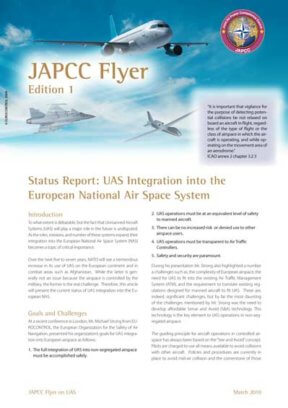Introduction
To what extent is debatable, but the fact that Unmanned Aircraft Systems (UAS) will play a major role in the future is undisputed. As the roles, missions, and number of these systems expand, their integration into the European National Air Space System (NAS) becomes a topic of critical importance.
Over the next five to seven years, NATO will see a tremendous increase in its use of UAS on the European continent and in combat areas such as Afghanistan. While the latter is generally not an issue because the airspace is controlled by the military, the former is the real challenge. Therefore, this article will present the current status of UAS integration into the European NAS.
Goals and Challenges
At a recent conference in London, Mr. Michael Strong from EUROCONTROL, the European Organization for the Safety of Air Navigation, presented his organization’s goals for UAS integration into European airspace as follows:
- The full integration of UAS into non-segregated airspace must be accomplished safely.
- UAS operations must be at an equivalent level of safety to manned aircraft.
- There can be no increased risk or denied use to other airspace users.
- UAS operations must be transparent to Air Traffic Controllers.
- Safety and security are paramount.
During his presentation Mr. Strong also highlighted a number a challenges such as, the complexity of European airspace, the need for UAS to fit into the existing Air Traffic Management System (ATM), and the requirement to translate existing regulations designed for manned aircraft to fit UAS. These are, indeed, significant challenges, but by far the most daunting of the challenges mentioned by Mr. Strong was the need to develop affordable Sense and Avoid (S&A) technology. This technology is the key element to UAS operations in non-segregated airspace.
The guiding principle for aircraft operations in controlled airspace has always been based on the “See and Avoid” concept. Pilots are charged to use all means available to avoid collisions with other aircraft. Policies and procedures are currently in place to avoid mid-air collision and the cornerstone of those procedures is the pilot’s ability to look outside of the aircraft, identify a conflict and take necessary actions to avoid disaster. By taking the pilot out of the aircraft, the bedrock of current procedures no longer exists. Hence, in order to safely operate UAS alongside manned systems a capability comparable to S&A must be established.
Sense and Avoid
This isn’t a secret nor is it a revelation, it is reality. In fact, the need for S&A technology was recently highlighted by the European Defence Agency (EDA) in their 17 June 2009 press release which stated, “The pilot’s responsibility to see and avoid needs an equivalent mechanism in UAS, hence a S&A system to determine the presence of potential collision threats and maneuvering clear of them.” As a result, five EDA Member States (France, Germany, Italy, Spain, and Sweden) have come together to address the issue through a project named MID-air Collision Avoidance System (MIDCAS). According to the previously mentioned press release, “the overall objectives of MIDCAS are to demonstrate the technology for a S&A system for UAS able to fulfil the requirements for traffic separation and mid-air collision avoidance in non-segregated airspace and, in close cooperation with European organizations such as, EUROCONTROL, EUROCAE (European Organization for Civil Aviation Equipment) and EASA (European Aviation Safety Agency), to provide technical background for them to establish a S&A standard.” This program has a 50 million Euro budget and will last for 48 months. The goal is to safely conduct a proof of concept UAS demonstration flight in non-segregated air space.
In addition to working with the EDA, EUROCONTROL is working on a project of its own. Theirs is a four-year, two-stream program to develop the framework and guidelines for UAS/ ATM integration. Stream 1 is the integration of UAS in the short to medium term (up to 2020) within the framework of the existing ATM regulatory, operational, and technical environment. Meaning they will work to wedge UAS systems into the existing airspace architecture. Stream 2, on the other hand, will focus on 2020 and beyond and will be in direct support to the Single European Sky ATM Research (SESAR) on ATM integration. In other words, Stream 2 will be the full integration of UAS into the ATM regulatory, operational, and technical environment. If UAS are to behave like manned aircraft and conduct transparent operations within existing regulations of the ATM system, it is clear that S&A technology and standards are the keys to the future.
Conclusion
How and when unmanned aircraft are authorized to conduct operations in and amongst the manned fleet is a question that garners many different answers depending on who you ask. In my opinion, the answer will likely be two-fold. First, the increased use of UAS will initially be dealt with as it has been so far: through segregation. UAS will be able to operate within the NAS, but only by exception and with prior coordination within very specific parameters. This method will continue over the next 10 to 20 years, and many will call it integration when in fact it is merely expanded segregation. Eventually, however, technological advances dealing with anti-collision, such as sense and avoid, will be proven and trusted. Only then will UAS be granted full access to the European NAS.











